
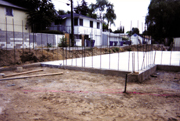
Take Southern California for example, an area that has one of the highest energy costs. Architects, developers, builders, etc., have all been searching for wall systems that will help control utility bills. Insulated concrete offers a solution. This answer is a structurally sound wall, built at roughly the same overall cost as a wood-framed structure and also includes much higher levels of sound-proofing, fireproofing, durability, insect/mold resistance and R-value.
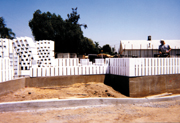
Back to schooling
For administration and maintenance space, the La Habra School District chose Arxx Building Products, of Cobourg, Ontario, over originally slated wood-framed construction."We were pursuing the approval of our product from the Division of State Architect-the governing body that oversees products usage and construction methods for schools throughout the State of California," says Randy Daniels, Arxx's California manager. "They have strict guidelines for public school construction. We're also in Seismic Zone 4 which made it even tougher."
For those who need an introduction to ICFs, the systems are polystyrene panels 4 feet by 16 3/4 inches tall that are stacked into the shape of the exterior walls and manufactured with a high-density plastic web 8 inches on center. The web is the "heart of the system" and has a three-fold purpose:
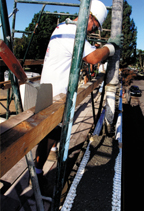
2. To extend through the form to both faces of the expanded polystyrene panels and engineered to hold the pressure of the plastic concrete. Most concrete form systems require strong backing or whalers-the Arxx system does not.
3. As the web extends to the exterior face on both sides, it's lined up vertically and is used as the fastening point for cladding, drywall, wire lath, sidings, etc. The advantage to drywall in particular is full sheets can be used without trying to hit a stud on the butt-end joints because the wall system is fully backed with no cavities between studs.
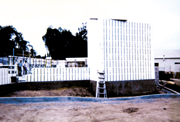
What has helped Arxx's system also gain some credible status was the "2001 Outstanding Green Product Award" issued from the Annual National Green Building Conference held in Seattle. The product was cited to have the most impact that advances resource efficient home building and R-value.
"Since the La Habra School District is only the second to use the system in the state," says Russ Wiersma, Paramount Ready-Mix, of Sante Fe Springs, Calif., "it took awhile for the architects to research it and approve it for use."
To encourage the use of Arxx's wall system, the company offered some of the product for free. In addition, the Southern California Ready-Mix Association aligned with Arxx to use the material because of its previous success, the first DSA-approved ICF project in California, a new office building for the San Luis Obispo County Office of Education.
After the DSA approved the project, construction began by the school's maintenance team. The La Habra School District was assisted by a support team to complete the project successfully. The assistance included Arxx's distributor, technical and sales teams, and Larry Maes of the Ready-Mix Association.
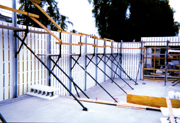
Ways of help
Because installation of the ICF units are still foreign to some, Arxx offers on- and off-site training to those that use the system."We hold one-day training courses across the country," says Daniels. "We'll hold at least 30 this year in California. We'd like to ensure that every project is a pleasant building experience. One of the aspects of the form system is it's lightweight and builder friendly. Sweat-equity labor is an option."
There are two levels to the training. Level 1 consists of a one-day hands-on classroom training, which covers construction process from footings and layout to concrete placement and wall alignment. There's a little bit on design of the project and how to make it builder friendly. The program material also provides an estimating module that allows the trainee to figure out the forms they need for their jobs. Sample walls are built right in the training facility. At days end there's a test and if successfully passed the company will issue a Level 1 diploma.
The second level happens on the job site. A technical manager will review the Arxx installation with a checklist. Once the project is under construction, critical items are checked off. At successful completion, a Level 2 seal and installer jacket is provided acknowledging the installer for his or her good ICF building practices.
"We don't help man the project with labor," says Daniels, "but assist when necessary with the proper building techniques."
The main problems of the job can arise well before the construction process, back to the inspectors and architects. Daniels illustrates the problems that may happen for the first-time user.
"If the inspectors haven't seen it (ICFs) before, it creates problems because of the 'magnifying glass.' It'll slow you down. As speed of construction is a true hallmark of the forms, enabling structures to go up quick, it'd be nice if there was no learning curve for inspectors, engineers, etc. First time exposure to building departments can result in delay unless we get in first with our code approvals and engineering materials."
The ICF cost $12,000 in materials for roughly 860 blocks of the 16 3/4-inch by 4-foot size.
Dennis Williams, maintenance and operations director of the La Habra School District approached the company because of cost cutting capabilities with the Arxx system. Wondering if the use of the ICF calls for unique and different tools, most users are happy to find that nothing too complex is involved: pruning saw, drill, table saw, wire pliers, and tape. Yes, even tape. Concrete pumping equipment is also usually required.
The basic outline for application is easily summarized.
"You pour a footing/slab," says Wiersma. "Steel rebar from the footing is usually spaced 16 inches on center vertically or as specified by the engineer. We then start in a corner with a corner form and do a first course layout around the whole building. And then we do a second course, alternating the block to create a running bond pattern. After that we plumb and level those first two courses of blocks with a transit or laser level. If there's a hump in the footing or slab, we can shim the forms, if we need to lower it, we'll trim the forms.
"We shoot the foam every 16 inches or so with spray foam adhesive (low expanding) under the blocks to help glue 'em down to the foundation so it doesn't move on us," Wiersma continues. "Then we'll place horizontal rebar into the center web notches, either to the left or right, alternating from course to course, for a true rebar weave. Engineers love that. Then up we go with the rest of the wall, bucking out the window and door
Russ Wiersma demonstrating proper placement of concrete with a boom pump.the worst and most costly in the nation. The ICF form system works best in extreme weather situations, whether frigid or tropic.
"If you're in extremes the wall has thermal mass that deadens the cold of night/the heat of day," says Wiersma. "It takes hours of cold on the exterior to come through and the same with heat. If you're conditioning that air, you'd need half the capacity to control that environment."
The job is near completion as a whole with the Arxx building envelope completed in October 2001. Daniels and Wiersma have also collaborated on residential homes in Rancho Cucamonga, Calif. According to growth trends they anticipate that the market for ICF's will move from its current position of 1 percent of wall construction to 15 percent within three to five years. In the interim there will be plenty of time to see the results of these initial projects, make improvements on existing systems and develop new ICF technology.


